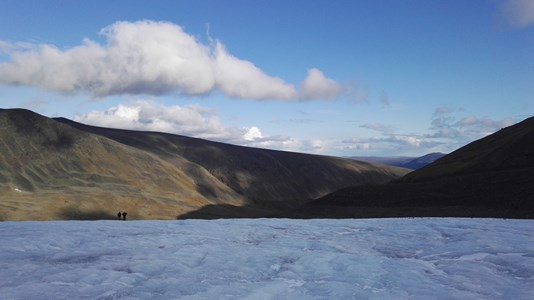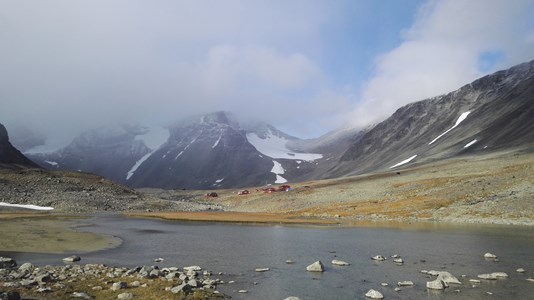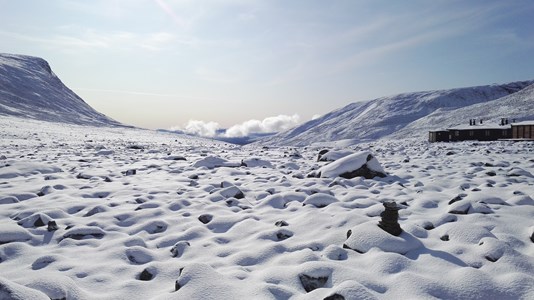With Stockholm University (SU) as the co-host of the 2019 meeting of the Council of UArctic, the pre-program excursion took us to Tarfala in northern Sweden, a research station owned and operated by the SU Department of Physical Geography.
In the Arctic you can never be too sure about the weather conditions, and there was snow to be expected during our visit. We were greeted by sunshine on the day of our arrival, so led by the station manager Gunhild (Ninis) Rosqvist we spent the afternoon hiking to the nearby Storglaciären.

Storglaciären is one of the best-studied glaciers in the world. The mass balance measurements – how much ice the glacier gains and loses over the year – began in 1946, and over the years the effects of the changing climate have become clear. The data shows that already since the 1950s the balance has been mostly negative, and since the mid-90's Storglaciären has been continuously melting. When you stand on the glacier, with roughly 100 metres of ice underneath your feet, it's difficult to wrap your head around the fact that it's slowly disappearing– and yet, that's what the measurements clearly tell us.
Tarfala welcomes researchers to conduct their field work during the station's active months from March to September. In addition to glaciology, there are studies done on e.g. climate, hydrology, microbiology and ecosystems. Thanks to its location and facilities, the station is also perfectly suited for field-based education and it is regularly used for that purpose as well. However, collaboration is not limited to students and researchers alone. Ninis told us that they have also worked with local Sámi reindeer herders to find common interests, and to get to know what each does. This exchange actually resulted in a joint project on monitoring weather and snow conditions in core grazing areas, with the aim to understand the effects of weather changes in reindeer health and movements. The combination of traditional knowledge from the herders and scientific measurements of the station has turned into a stronger message on what is happening in the area and how it affects the local people and animals.

Using the data and putting it in a larger context is key to what they do in Tarfala. It is important for education and science and also for wider purposes, as the joint project with the local reindeer herders shows. But there is still work to do in finding ways to reach out and inform people of the importance of the studies done at the station, and especially the importance of their findings. As Ninis put it, "we know what we are doing here – but we need to step up."
I heard this thought echoed in all the discussions during our excursion. The only way to create development that benefits everyone and is sustainable is to add science and knowledge in the mix. We need facts, research and data to guide decision-making, and we need to understand the context. In order to find solutions to complex problems – the kind that we face in the Arctic – we need engagement from multiple parties to see the whole picture. We need to establish connections, learn from each other, and share our expertise and experiences.
I've been working with UArctic communications for some years now, so this message is familiar to me. It's written in our strategy, I see it materializing through joint projects and collaboration within the network, and I also witness it in UArctic meetings, no matter where we are. But at the same time, the excursion to Tarfala felt like finding a missing piece to a puzzle.

I now truly understand why it is so important to visit other places in the North, because you only get a sense of a place, its stories and connections, when you experience it yourself. It's especially important for students and scientists, getting new knowledge and perspective and meeting people, and I can honestly say that for me it was almost overwhelming to find myself in that environment and finally hear that little 'click' of things falling into place. No amount of words or pictures would have the same effect.
Tarfala and other research stations within our network connect us to different parts of the Arctic, show us what is happening around the region, and provide immensely valuable learning and research opportunities. I now have a much deeper appreciation for research and the researchers in the field, working in difficult conditions to collect data and sharing their findings to help us make well-informed choices. Finally, it all comes down to all of us working together: communities, scientists, organizations, governments – the people of the Arctic. It may sound like an overused statement, but I don't think we can emphasize it enough.
Hannele Palviainen, Communications Coordinator, UArctic International Secretariat
